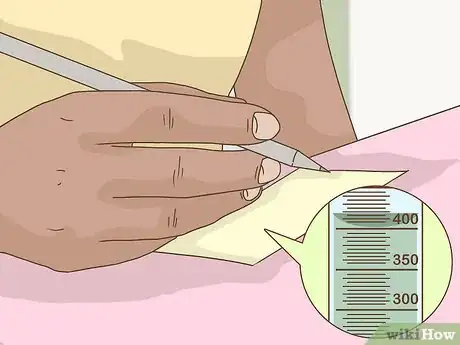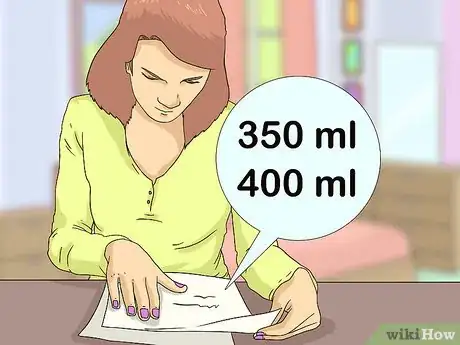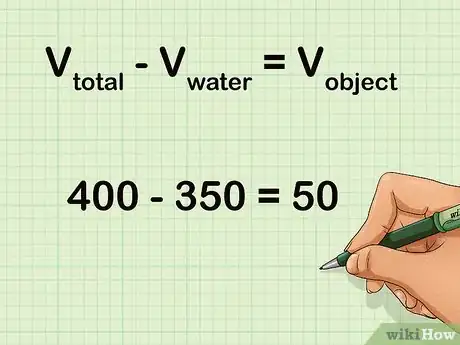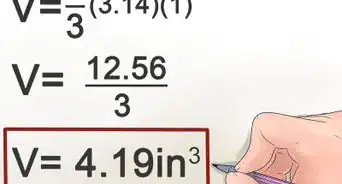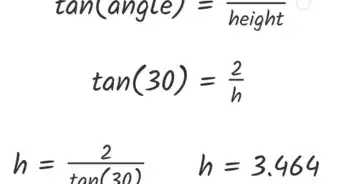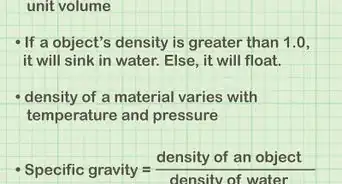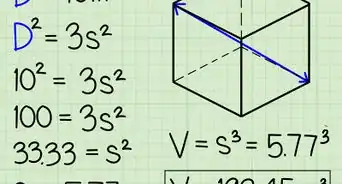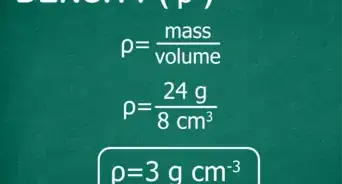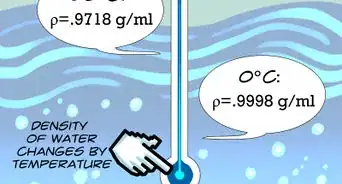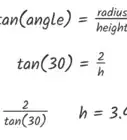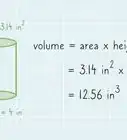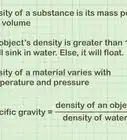This article was co-authored by wikiHow Staff. Our trained team of editors and researchers validate articles for accuracy and comprehensiveness. wikiHow's Content Management Team carefully monitors the work from our editorial staff to ensure that each article is backed by trusted research and meets our high quality standards.
This article has been viewed 243,464 times.
Learn more...
Finding the volume of a regular object, such as cube or sphere, is typically done using an equation. Irregular objects like a screw or rock require a more hands on approach. Luckily, there is a straightforward way to calculate the volume of irregular objects using the water levels in a graduated cylinder.
Steps
Reading the Initial Water Level
-
1Add water to a graduated cylinder. Choose a graduated cylinder that the object will easily fit inside. Tilt the cylinder while pouring the water to reduce bubbles. Pour enough water in to fill the cylinder to the halfway mark.
-
2Read the meniscus. You will notice that the water is higher on the sides of the cylinder and droops slightly in the middle. This droop is known as the meniscus and is the standard point at which the water level is measured. Make sure that the cylinder is on a flat, level surface and that there are no bubbles. Look closely where the meniscus rests.[1]Advertisement
-
3Record your measurement. It will be important to know the initial water level exactly. Write down the measurement that you took in a table or lab notebook. Your measurement will be mL. [2]
Measuring the Final Water Level
-
1Submerge your object. Tilt the cylinder. Slide the object into the water slightly. Be sure that your object is completely submerged in the water. If there is not enough water to submerge the object, you will have to start over with more water in the cylinder.
-
2Take a new measurement. Let the object and the water settle. Make sure that the cylinder is on a flat level surface. Now look at the water level (again read the meniscus). The water level should have increased with the object being added to the cylinder.[3]
-
3Record your final measurement. The final measurement will be just as important as the initial measurement in your calculations. It too must be precise. Write down the final water level in mL in your table or lab notebook.[4]
Calculating the Volume of Your Object
-
1Understand the measurements. Some people jump to the conclusion that the final reading gives them the volume of their object, but this is incorrect. The final reading is the volume of water plus the volume of your object. You will need to find the difference of the final and initial readings to know the volume of your object.[5]
-
2Solve for the difference between water levels. You will set up the equation Vtotal - Vwater = Vobject. Vtotal is your final measurement, Vwater is your initial measurement, and Vobject is the volume of your object. In other words, subtract the first measurement from the second to find the volume of your object.[6]
-
3Analyze your answer. Make sure that the volume you calculate makes sense. Obviously, you can check your calculation with a calculator. Some obvious signs of a mistake are things like your object having negative volume (this isn't possible) or a volume larger than the cylinder could hold (a volume of 30 mL cannot be measured in a 25 mL cylinder). If your answer seems wrong, you should first check your equation to make sure you did the math properly. If you did, you will have to redo the experiment and obtain new measurements.[7]
- If you found a negative volume, it is likely that you simply mixed up the initial and final measurements in your equation and do not need to redo the experiment.
- If you obtain a number too large to be reasonable, you either made an arithmetic error or wrote down incorrect measurements. If it is the latter, you will have to redo the experiment.
Community Q&A
-
QuestionWhat is the formula to find the volume of an irregular object?
 Community AnswerThere is no formula; however, you can take the object and place it in a jar of precisely measured water, then place the object in the water. Watch the amount of ml (or liters depending on how large the object is). The amount it goes up or displaces the water to is the volume of the object.
Community AnswerThere is no formula; however, you can take the object and place it in a jar of precisely measured water, then place the object in the water. Watch the amount of ml (or liters depending on how large the object is). The amount it goes up or displaces the water to is the volume of the object. -
QuestionWhy does one use a measuring cylinder to find the volume of an irregular solid object?
 Community AnswerYou need to find the difference between initial and final readings to know the volume of your object.
Community AnswerYou need to find the difference between initial and final readings to know the volume of your object. -
QuestionIs water displacement a good way to find the volume of irregular objects?
 Community AnswerYes, it is.
Community AnswerYes, it is.
Things You'll Need
- A Graduated Cylinder
- Water
- An Object
References
- ↑ http://www.biologyjunction.com/volume_of_irregular_object_lab.htm
- ↑ http://www.middleschoolchemistry.com/lessonplans/chapter3/lesson2
- ↑ http://www.biologyjunction.com/volume_of_irregular_object_lab.htm
- ↑ http://www.biologyjunction.com/volume_of_irregular_object_lab.htm
- ↑ http://www.middleschoolchemistry.com/lessonplans/chapter3/lesson2
- ↑ http://www.middleschoolchemistry.com/lessonplans/chapter3/lesson2
- ↑ http://www.middleschoolchemistry.com/lessonplans/chapter3/lesson2
About This Article
To find the volume of an irregular object using a graduated cylinder, start by adding water to a cylinder that can accommodate the size of the object and write down the measurement for the current water level. Next, slide the object into the water, let it settle at the bottom of the cylinder, and record the new water level measurement. Then, subtract the first measurement from the second measurement to calculate the volume of your object! For tips on properly interpreting the meniscus, read on!





